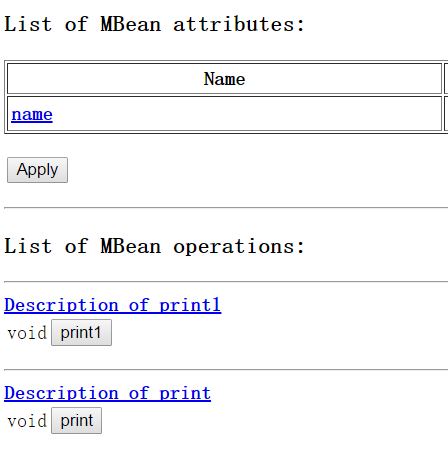从零开始玩转JMX(4):Apache Commons Modeler & Dynamic MBean,jmxmodeler
从零开始玩转JMX(4):Apache Commons Modeler & Dynamic MBean,jmxmodeler
Apache Commons Modeler
前面的Model MBean的创建方式看上去特别复杂,一个简单功能的类ModelMBeanUtils 写了很多代码,那有木有简单点的方式呢,答案是肯定的,这里就引出了Apache Commons Modeler(使用这个需要在classpath中导入commons-modeler-2.0.1.jar以及modeler的依赖项目commons-logging-1.1.3.jar,下载地址:http://commons.apache.org/proper/commons-modeler/download_modeler.cgi),使用Apache的Moleler库创建Model MBean最大帮助是,我们不需要再写复杂的代码来创建ModelMBeanInfo对象了。只需要一个MBean描述符(实际上就是一个xml配置文件,Apache Commons Modeler将ModelMBeanUtils 复杂的创建过程转移到xml中来配置,然后自身模块创建对象代替ModelMBeanUtils 的功能,简化用户的操作)来对Model MBean进行描述,就可以轻松的创建Model MBean.
下面来讲前面的Hello.Java和HelloAgent.java的例子采用Apache Commons Modele进行改造。
首先还是Hello.java,和Model MBean中的一样,没有implements任何接口。
package com.test.jmx.modeler;
public class Hello{
private String name;
public String getName() {
return name;
}
public void setName(String name) {
this.name= name;
}
public void printHello() {
System.out.println("Hello World, "+name);
}
public void printHello(String whoName) {
System.out.println("Hello, "+whoName);
}
}
接下去就是最关键的描述文件(mbeans-descriptors.xml)了:
<?xml version="1.0" encoding="UTF-8" ?>
<mbeans-descriptors>
<mbean name="Hello" description="the hello bean" domain="MyMBean" group="helloGroup" type="com.test.jmx.modeler.Hello">
<attribute name="name" description="a name attribute" type="java.lang.String" writeable="true"/>
<operation name="printHello" description="public void printHello()" impact="ACTION" returnType="void"/>
<operation name="printHello" description="public void printHello(String whoName)" impact="ACTION" returnType="void">
<parameter name="whoName" description="method parameter of printHello" type="java.lang.String"></parameter>
</operation>
</mbean>
</mbeans-descriptors>
描述文件的名字可以随意,最主要的是要和下面的HelloAgent.java对应起来。
通过这个xml文件的定义就描述了Model MBean所需要的metadata信息和一个基本的ModelMBean实现。
关于这个xml文件有几个需要说明的地方:
<mbean>的属性classname,name,type:
- name属性是每个MBean被Registry对象注册的对象名
- type属性是真正被管理资源的全面(包括包名)
- classname属性是用户扩展的用于实现代理功能的Model MBean的全名,如果不提供Modeler会使用BaseModelMBean;如果提供了代理的ModelMBean对象,在使用时可以使用如下的代码样本访问他所代理的资源对象。
其余的标签就比较好理解了。综述:上面所示代码声明了一个Model MBean, 唯一标示是“Hello”,该MBean负责管理的对象是com.test.jmx.modeler.Hello的实例。域是MyMBean。这个MBean暴露了一个属性name和两个方法printHello()和printHello(String whoName).
下面是新的HelloAgent.java的代码:
package com.test.jmx.modeler;
import com.sun.jdmk.comm.HtmlAdaptorServer;
import org.apache.commons.modeler.ManagedBean;
import org.apache.commons.modeler.Registry;
import javax.management.MBeanServer;
import javax.management.ObjectName;
import javax.management.modelmbean.ModelMBean;
import java.io.InputStream;
public class HelloAgent {
public static void main(String[] args) throws Exception {
// 需要将xml信息读入到Registry对象中
Registry registry = Registry.getRegistry(null,null);
InputStream stream = HelloAgent.class.getResourceAsStream("mbeans-descriptors.xml");
registry.loadMetadata(stream);
MBeanServer server = registry.getMBeanServer();
// 之前是:MBeanServer server = ManagementFactory.getPlatformMBeanServer();
ManagedBean managed = registry.findManagedBean("Hello");
ObjectName helloName = new ObjectName(managed.getDomain()+":name=HelloWorld");
// 以前是Hello hello = new Hello(); 为什么要多个createMBean?因为现在的写法没有写MBean,所以才要动态生成一个,以前就直接
// 把new hello()注册到MBeanServer就可以了,server会自动找到它的HelloMBean接口文件。
ModelMBean hello = managed.createMBean(new Hello());
server.registerMBean(hello,helloName);
ObjectName adapterName = new ObjectName(managed.getDomain()+":name = htmladapter,port=8082");
HtmlAdaptorServer adapter = new HtmlAdaptorServer();
server.registerMBean(adapter,adapterName);
adapter.start();
}
}
注意这里的Registry是指org.apache.commons.modeler.Registry,因为JMX自身也有一个Registry(java.rmi.registry.Registry)。通过Modeler组件提供的Registry对象,可以很方便的完成MBeanServer的创建。
运行效果和之前的一样,这里就不赘述了,有兴趣的小伙伴可以试一下。
Dynamic MBean
四种类型的MBean,前面所讲的都是常用的,现在还剩两种Open MBean就不讲述了,这里简单记录下Dynamic MBean。
Dynamic MBean不需要自定义MBean接口,只需要实现DynamicMBean接口即可,Dynamic MBean没有任何明显些在代码里的属性和方法,所有的属性和方法都是通过反射结合JMX提供的辅助元数据从而动态生成。
下面的代码中首先定义了一个属性name和一个方法print,之后在管理界面(localhost:8082)中点击print之后生成一个print1的方法。
Dynamic MBean的代码如下:
package com.test.jmx.DynamicMBean;
import javax.management.*;
import java.lang.reflect.Constructor;
import java.util.Iterator;
/**
* Created by hidden on 2016/10/9.
*/
public class HelloDynamic implements DynamicMBean {
private String name;
private MBeanInfo mBeanInfo = null;
private String className;
private String description;
private MBeanAttributeInfo[] attributes;
private MBeanConstructorInfo[] constructors;
private MBeanOperationInfo[] operations;
MBeanNotificationInfo[] mBeanNotificationInfoArray;
private void init(){
className = this.getClass().getName();
description = "Simple implementation of a dynamic MBean.";
attributes = new MBeanAttributeInfo[1];
constructors = new MBeanConstructorInfo[1];
operations = new MBeanOperationInfo[1];
mBeanNotificationInfoArray = new MBeanNotificationInfo[0];
}
private void buildDynamicMBean(){
Constructor[] thisConstructors = this.getClass().getConstructors();
constructors[0] = new MBeanConstructorInfo("HelloDynamic(): Constructs a HelloDynamic Object",thisConstructors[0]);
attributes[0] = new MBeanAttributeInfo("name","java.lang.String","Name:name string.",true,true,false);
MBeanParameterInfo[] params = null;
operations[0] = new MBeanOperationInfo("print","print():print the name",params,"void",MBeanOperationInfo.INFO);
mBeanInfo = new MBeanInfo(className,description,attributes,constructors,operations,mBeanNotificationInfoArray);
}
public HelloDynamic(){
init();
buildDynamicMBean();
}
private void dynamicAddOperation(){
init();
operations = new MBeanOperationInfo[2];
buildDynamicMBean();
operations[1] = new MBeanOperationInfo("print1","print1():print the name",null,"void",MBeanOperationInfo.INFO);
mBeanInfo = new MBeanInfo(className,description,attributes,constructors,operations,mBeanNotificationInfoArray);
}
@Override
public Object getAttribute(String attribute) throws AttributeNotFoundException, MBeanException, ReflectionException {
if (attribute == null) {
return null;
}
if (attribute.equals("Name")) {
return name;
}
return null;
}
@Override
public void setAttribute(Attribute attribute) throws AttributeNotFoundException, InvalidAttributeValueException, MBeanException, ReflectionException {
if (attribute == null) {
return;
}
String Name = attribute.getName();
Object value = attribute.getValue();
try {
if (Name.equals("Name")) {
if (value == null) {
name=null;
} else if (Class.forName("java.lang.String").isAssignableFrom(value.getClass())) {
name = (String) name;
}
}
} catch (ClassNotFoundException e) {
e.printStackTrace();
}
}
@Override
public AttributeList getAttributes(String[] attributes) {
if (attributes == null) {
return null;
}
AttributeList resultList = new AttributeList();
// if (attributes.length == 0) {
// return resultList;
// }
for(int i=0;i<attributes.length;i++){
try {
Object value = getAttribute(attributes[i]);
resultList.add(new Attribute(attributes[i],value));
} catch (AttributeNotFoundException e) {
e.printStackTrace();
} catch (MBeanException e) {
e.printStackTrace();
} catch (ReflectionException e) {
e.printStackTrace();
}
}
return resultList;
}
@Override
public AttributeList setAttributes(AttributeList attributes) {
if (attributes == null) {
return null;
}
AttributeList resultList = new AttributeList();
if(attributes.isEmpty()){
return resultList;
}
for(Iterator i = attributes.iterator();i.hasNext();){
Attribute attr = (Attribute) i.next();
try {
setAttribute(attr);
String name = attr.getName();
Object value = getAttribute(name);
resultList.add(new Attribute(name,value));
} catch (AttributeNotFoundException e) {
e.printStackTrace();
} catch (InvalidAttributeValueException e) {
e.printStackTrace();
} catch (MBeanException e) {
e.printStackTrace();
} catch (ReflectionException e) {
e.printStackTrace();
}
}
return resultList;
}
@Override
public Object invoke(String actionName, Object[] params, String[] signature) throws MBeanException, ReflectionException {
if(actionName.equals("print")){
System.out.println("Hello, "+name+",this is HelloDynamic!");
dynamicAddOperation();
return null;
}else if(actionName.equals("print1")){
System.out.println("这是动态增加的一个方法print1");
return null;
}else {
throw new ReflectionException(new NoSuchMethodException(actionName),"Cannot find the operation "+actionName+" in "+className);
}
}
@Override
public MBeanInfo getMBeanInfo() {
return mBeanInfo;
}
}
通过Agent调用Dynamic MBean:
package com.test.jmx.DynamicMBean;
import com.sun.jdmk.comm.HtmlAdaptorServer;
import javax.management.*;
import java.lang.management.ManagementFactory;
import java.util.concurrent.TimeUnit;
public class HelloAgent {
public static void main(String[] args) throws MalformedObjectNameException, NotCompliantMBeanException, InstanceAlreadyExistsException, MBeanRegistrationException {
MBeanServer server = ManagementFactory.getPlatformMBeanServer();
ObjectName helloName = new ObjectName("MyMBean:name=helloDynamic");
HelloDynamic hello = new HelloDynamic();
server.registerMBean(hello,helloName);
ObjectName adapterName = new ObjectName("MyMBean:name=htmladapter");
HtmlAdaptorServer adapter = new HtmlAdaptorServer();
server.registerMBean(adapter,adapterName);
adapter.start();
}
}
运行效果图如下:

运行结果:
Hello, null,this is HelloDynamic! 这是动态增加的一个方法print1
wanna more?
- 从零开始玩转JMX(1):简介和 Standard MBean
- 从零开始玩转JMX(2):Condition
- 从零开始玩转JMX(3):Model MBean
- 从零开始玩转JMX(4):Apache Commons Modeler & Dynamic MBean
参考资料
- JMX整理
- JMX简介
- http://blog.csdn.net/DryKillLogic/article/category/762777
- 用Apache的commons-modeler来辅助开发JMX
用户点评